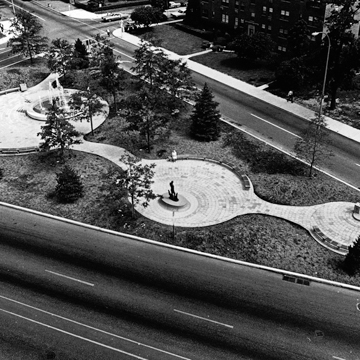The triangular park occupies the site of Kennett Apartments, which civic leader Henry Belin du Pont deemed ugly. He bought them in 1965 to demolish them and create this park, among the first works by Bachtle after establishing a landscape design practice in Wilmington in 1965—the first person, he thought, ever to do so (Wilmingtonian Robert Wheelwright, for whom Bachtle briefly worked, was based in Philadelphia). The park has ivy-covered earth mounds, curving benches, and stone paving in biomorphic patterns. Bachtle, who attended Harvard University for his graduate studies and cited landscape architect Roberto Burle Marx as a chief influence, chose plant types resistant to gasoline vapors. A focus is the sculpture of a boy and two dogs, American Youth (1967, Charles C. Parks), a welcome addition to Wilmington's park statuary, which, in 1964, numbered just ten pieces, compared to Philadelphia's 150.
One block north is another triangular park, Columbus Square (1956–1957, Leon N. Fagnani), featuring a 1,600-pound bronze statue of the Genoese explorer modeled in Rome by Egidio Giaroli, a sculptor later favored by Pope Paul VI. The Italian Societies of Wilmington conceived of Columbus Square.






